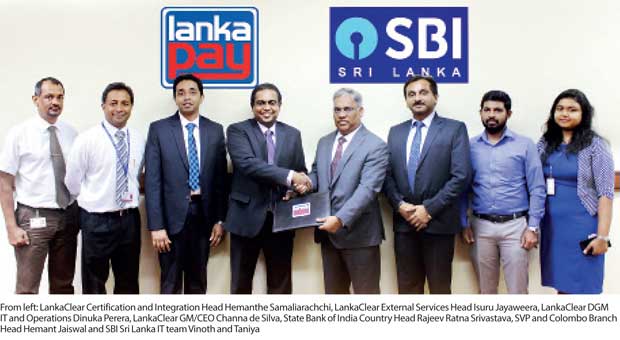22 Jan 2018 - {{hitsCtrl.values.hits}}

In light of its current expansion strategy, State Bank of India (SBI) Sri Lanka branch recently joined LankaPay Common ATM Network taking a leap towards enhancing customer convenience.
With legacy since 1806 as Bank of Calcutta, SBI came into existence in 1955. It is the largest bank in India with over 24,000 branches, 59,000 ATMs and 190 foreign offices in 36 countries.
The bank, with 22 percent market share in the Indian banking industry, secured a place in the league of ‘Top 50 Global Banks’ with balance sheet size of INR 41 trillion and ranked 232nd in Fortune Global 500 world’s biggest corporation as of 2016.
SBI commenced its operation in Sri Lanka in 1864 and primarily focused on corporate banking till recent times, prior to the new strategic direction of diversifying into retail banking.
Speaking of the partnership with LankaPay, SBI Sri Lanka Country Head Rajeev Ratna Srivastava stated, “SBI is the leading bank in India and many other countries and after being in continuous service of people of Sri Lanka for more than 153 years, we now aspire to become the preferred bank of the masses in Sri Lanka.
We are in the process of bringing in our expertise in technology from all over the world to serve Sri Lanka in the most convenient and efficient manner.
Joining the common ATM switch is one such step in addition to latest changes in our Internet banking and banking on mobile facilities, which are in place now. Lanka pay has taken excellent efforts to enhance the banking experience of customers by providing various technology platforms like CAS, CEFT and common PoS switch. They have been continuously working on providing the latest in technology platforms to Sri Lanka banking industry and we are happy to associate with them in this journey.”
Welcoming SBI on board, LankaClear (Pvt.) Ltd GM/CEO Channa de Silva said, “We, at LankaClear, are delighted to have the SBI joining LankaPay umbrella as the 27th member of the LankaPay Common ATM Switch (CAS). We believe this partnership would be of great significance to all SBI customers in providing accessibility to any of the 4000+ ATMs currently connected to the LankaPay Common ATM Network. With its focus on retail banking, SBI is now able to provide ultimate convenience to all its retail customers by allowing them access to their bank account across the entire island.”
Launched in 2013, LankaPay CAS now has grown to connect almost 99.5 percent of the ATMs in the country with the participation of 28 members. Over the years, LankaPay has been able to enhance the efficiency of the country’s banking infrastructure by enabling common usage of resources while providing unprecedented level of convenience to the public.
The ultimate beneficiaries are the holders of nearly 18 million bank accounts in the country by allowing them to access their bank account literally via any ATM. Currently, the network routes over four million interbank ATM transactions, which amounts to almost 15 percent of the total number of ATM transactions in the country.
The other members of the network are Bank of Ceylon, Commercial Bank, ICICI Bank, HNB, NDB, People’s Bank, Seylan Bank, Union Bank, NTB, Standard Chartered, Cargills Bank, Habib Bank, Regional Development Bank, Pan Asia Banking Corporation, Sampath Bank, Public Bank, DFCC Bank, HDFC Bank, MCB bank, NSB bank, Axis Bank, Amana Bank, HSBC, Commercial Credit and Finance, Bimputh Finance PLC, Indian Bank and Sarvodaya Finance.
LankaPay CAS went live as the Phase I of the Common Card and Payment Switch, which is envisioned to be the backbone of all domestic electronic payments in future.
The launch of LankaPay Common ATM Network in 2013 marked a significant milestone in the country’s banking sector through common usage of resources generating greater economies of scale whilst enhancing customer convenience.
Consequently, the transaction cost to the banks and customers have come down drastically by almost tenfold, saving the country billions of foreign exchange that would have otherwise drained out of the country.
28 Dec 2024 17 minute ago
28 Dec 2024 1 hours ago
28 Dec 2024 4 hours ago
28 Dec 2024 5 hours ago
28 Dec 2024 5 hours ago